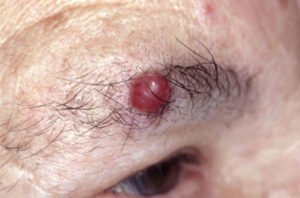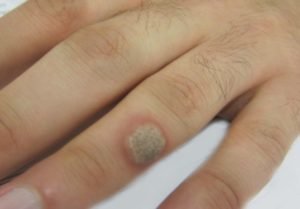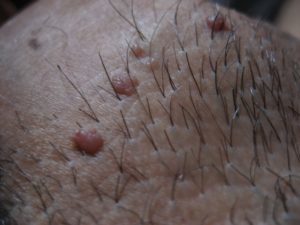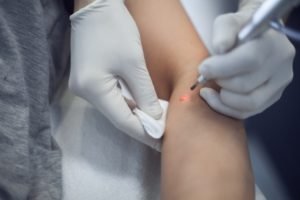
The human papillomavirus (HPV) is located exclusively in the basal layer of the skin, and reproduction occurs in the upper layers. This disease is characterized its chronic form with periodic relapses.
Read more about HPV, its description
HPV infected more than half the world's population. Some of them are simply carriers of the disease, and others this virus is manifested as papillomatosis of the skin, mucous membranes. Sometimes this viral disease can be the causative agent of the cancerous degeneration of cells. HPV is the infection of the family Papovaviridea that can infect and change skin cells. This benign tumor is formed in any area of the body:
- the neck;
- under the Breasts;
- on the abdomen;
- face;
- the genitals;
- in the armpits;
- on the mucous membranes of the oral, nasal cavities, lips;
- on the mucous membranes of the internal organs.
This infection is related to intracellular parasites that are unable to self-replicate, and use human cells. The virus injects its DNA into the chromosomes of a person and so he is a parasite long enough. At decrease in immunity it is possible to observe a noticeable intensification of the disease. This fact caused the need for treatment for HPV. The development of this infection occurs in the cells of the body, but exist outside of it he can too, but not for long. While in the cells of a living organism it causes a failure in their division.

The incubation period and stages of development
The incubation period of the virus varies. For this type of virus is characteristic latent period. Subclinical form of the disease, the characteristic appearance of the invisible with a simple examination of the lesions that cause discomfort to the patient in the genital area. Once you can get several varieties of papillomaviruses. Under the influence of some factors aktiviziruyutsya virus and starts its multiplication and the disease enters a period of clinical manifestations. In 90% of cases for six months or a year on their own, and in some cases can occur chronic relapsing course with a high likelihood of a malignancy (depends on type of virus). The disease occurs in four phases (stages):
Stage 1 (initial) – latent period of HPV infection. The virus is in the body, but not shown, causes transformation in cells. At this stage, it can reveal the PCR analysis;
2 – there are clinical signs – in the form of growths on the skin. The virus causes rapid division of epidermal cells. At this stage, the virus is detected by PCR, Cytology and histology (detected by the presence of hyperkeratosis);
3 – dysplasia. Changes in the structure of cells (coloridos) is seen under the microscope, so the DNA of the virus begins to interact with the DNA of cells and causes the development of so-called integrated form. For diagnosis use of PCR, methods of Cytology and histology, and colposcopy;
Stage 4 – cancer. The virus causes cell mutation and formation of malignant cells. Invasive cancer is formed. Diagnosis occurs all of the above methods and according to clinical manifestations.
The types of HPV
Defined in more than one hundred types of HPV infecting urogenitalny tract, affecting the epithelium of skin and mucous membranes of the genitals – 35 types. For all HPV types using a classification based on types manifested as warts, rashes and other skin manifestations. Typing of HPV with a description looks like this:
- different types of warts – for their appearance of HPV responsible 1-5 type;
- plantar warts (they resemble corn) – 1-4 types of HPV. Usually formed in those places where there is rubbing blisters or squeezing. In places the skin becomes thicker and when pressing it causes discomfort. These warts do not resolve spontaneously and need surgical removal. There are two subspecies of plantar warts. One kind grows deep into the tissue and it hurts the other type is similar to multiple growths, as if glued to each other – this type of warts doesn't make the sensation of pain
- flat warts– 3, 5, 10, 28, 49 types. Most often affect the palms, face. They are usually found in young people and because of this, this type of warts are called youth. Often the body itself to cope with this infection;
- common warts – HPV type 27;
- vulgar warts – the virus type 2 (usually the body itself to cope with this type of virus). It is contagious through casual contact;
- genital warts, which affects women vagina, vulva, genitals, cervix, anus, men can be on the head of the penis, on the skin of the foreskin, also found their location in the respiratory tract the types 6, 11, 13, 16,18, 33, 35;
- HPV high-risk types, causing a precancerous condition – 39 type.
- found warty epidermodysplasia. It is of two types: HPV 5, 8, 47 types – skin cancer is 9 times out of 10 the virus is present in patient's blood, another type of HPV 14, 20, 21, 25 types of causes usually benign tumors;
- laryngeal papillomatosis — a virus 11 type. Usually transmitted from mother to child, but infection during oral sex. Causes difficulties with swallowing, hoarseness, if the number of large papillomas impairs breathing;
- boveney papulez. This kind of triggered a 16, sometimes 18, 31-35, 42, 48, 51-54 types of HPV. This files most often can occur in members of the male half who have many sexual partners. Externally, these structures appear as semi-circular or flat growths with a smooth or rough surface, color varies from very light to almost black. The disease can pass itself is neocolony type of virus.

Symptoms and specificity of HPV occurrence in men, women and children
In order to fight the infection in the early stages of human immunity is strong enough. Most often the disease does not develop and the presence of HPV the person does not even suspect, because external symptoms may not occur. But after some time (months or years) there may be some signs of HPV infection. Statistics say only about 5-10% of cases, which is present external symptoms of the disease HPV (Human papillomavirus). The disease is asymptomatic — most of cases has no symptoms. When activated, the virus can cause growths of various kinds, which indicate the presence in the body of HPV of different types. Locations are also talking about the type of virus. For example, papillomas, are soft, elongated warts (filiform warts), which are mounted on the stem, the color may not vary from skin color, but sometimes pigmented. May appear rod-like growths, soft to the touch, pinkish color.
In women, the specificity of the disease is that the disease is able to occur in a latent form, and sometimes causes the formation of genital warts. Infected with the virus, the woman may not observe any symptoms until menopause, at which time the virus could trigger a malignancy of the cells lining the genital organs. To prevent cervical cancer caused by HPV infection, can help of a regular medical examination. Because apparently the disease may not manifest itself. In children under the influence of the virus may develop warts on the skin, papillomatosis of the larynx (usually in the chronic recurrent form). Papillomatosis of the larynx causing breathing problems, until the syndrome of breathlessness. Skin warts are present in 12 % of the students, this is the most common dermatologic disease in children.

HPV and pregnancy
HPV in pregnant women is not the most dangerous disease for herself and the unborn child. The future mother should only alert if it has detected 6 or type 11 HPV (causing genital or anal warts), which when passing the newborn can have consequences in the form of respiratory papillomatosis. In the presence of warts in such numbers or locations that prevent the expulsion of the fetus you can assign a C, as in normal childbirth genital warts may cause bleeding development. All other forms of papillomavirus (reconciliatory lesions) are not dangerous for the child and pregnancy.
Diagnosis and who should I contact
For the diagnosis of human papillomavirus apply the following research methods:
- a personal examination of the patient;
- blood test;
- colposcopy;
- Cytology smear – a PAP test;
- histology tissue;
- PCR – polymerase chain reaction. This analysis allows not only to learn about the presence of the virus, but also to determine its type. But if the test is positive, this does not mean that this type of HPV will not pass on their own. This analysis also determines all kinds of HPV;
- urethroscopy;
- biopsy.

If external signs in the form of rashes, no complaints from the patient are not available, and the presence of HPV DNA defined only on tests – it can go from a transient viral infection (person is a carrier). Due to the fact that HPV can cause diseases of different organs, if any visits to physicians in various fields. In the presence of warts on the skin of the face and body turn to a dermatologist. When the plantar warts is a dermatologist or surgeon. When warts in men to a urologist (surgeon), women – to the gynecologist (surgeon). If warts are present in the area of the anus, you should go to the proctologist. If you suspect barodawala epidermodysplasia to the dermatologist or the oncologist. Laryngeal papillomatosis requires treatment by the audiologist or surgeon, boveney papulez – it is necessary to address to the urologist or the venereologist. Also requires differential diagnosis with diseases such as micropapillae, vestibular papillomatosis – they, unlike HPV do not require treatment, since the similarity of the external signs are anatomical variant of normal. Transcript of standard values in blood tests will show the absence of HPV.
Treatment
So fully treated HPV or not? To date, not aware of any antiviral drug that can remove the HPV from the body. Different interferons and other drugs in this series – just save existing warts, but do not reduce the incidence of new. The main method of treatment is the removal of warts. The main removal methods are:
- surgical. It is performed under local anesthesia;
- radiosurgery. Radiowave electrode cuts the tumor, koaguliruut vessels. After is antiseptic bandage;
- laser. This method is non-contact and bloodless. Spot removal remains a crust, under it there is a healing. Disadvantage is the high risk of disease recurrence, relatively high price and the need for sanding the remaining scars;
- electrocoagulation. The results and effectiveness similar to the two previous options;
- cryocoagulation. Complete removal of papillomas occurs after a few sessions.
Although using these methods and there is a complete removal of the external manifestations of the virus, it is not considered an absolute freedom from infection, but only relative, as the person ceases to be infected with HIV, and after some time warts can recur. Universal method of non-surgical treatment for all categories of patients (men, women, and children) does not exist. The alternative can only be considered laser removal. But in its application there is a risk of malignancy (of malignancy) papillomas. After the operation the patient is prescribed an infusion of one dose of a steroid drug that prevents swelling also prescribe antibiotics to prevent wound infections. During therapy of HPV completely discontinue their sexual activity before full treatment and to be examined and, if necessary, treatment of the partner.

Treatment in the home and folk remedies
In addition to traditional treatment methods, use and other officially recognised by medicine, and which can be done at home:
- Treatment of warts salicylic acid. Every day should be treated warts with acid solution (15-20%). This method has one drawback – the treatment should be to produce for quite a long time;
- Treatment cream. They lubricate the warts three times a week. But when you apply you can feel itching, possible erosion, redness of the skin;
- Retinoids in the form of a cream. Treated warts within 12 weeks. Its use is also prohibited during pregnancy;
- Injection at the site of infection once in 7 days for three to four weeks. The use of prohibited during pregnancy;
- Cauterize warts, papillomas and kill the pathogenic microbes. To treat the wart must be constantly within the hour. Then adjourned for a week and is still processing. If it does not disappear in 14 days is another treatment, and so no more than 4 treatments. Prohibits the application of senile warts and in Pediatrics;
If we talk purely about the treatment of folk remedies, here are the most popular use of celandine. His juice treat a wart several times a day. When it will darken, the dark skin is removed and continues to smear further in order to fully remove warts.
Prevention of the disease
The main measures of prevention are:

- personal hygiene in public places;
- adherence to a healthy lifestyle, maintaining immunity;
- one permanent sexual partner during intercourse with an untested partner to use a condom;
- sufficient intake of vitamins;
- sexually active not earlier than 18 years of age when the mucous of the cervix is already quite Mature and could defend themselves;
- to avoid induced abortions and rough sex;
- time to treat inflammatory diseases.
If vaccination is sometimes you may experience some side effects such as deterioration of health, fever, redness at the injection site.























